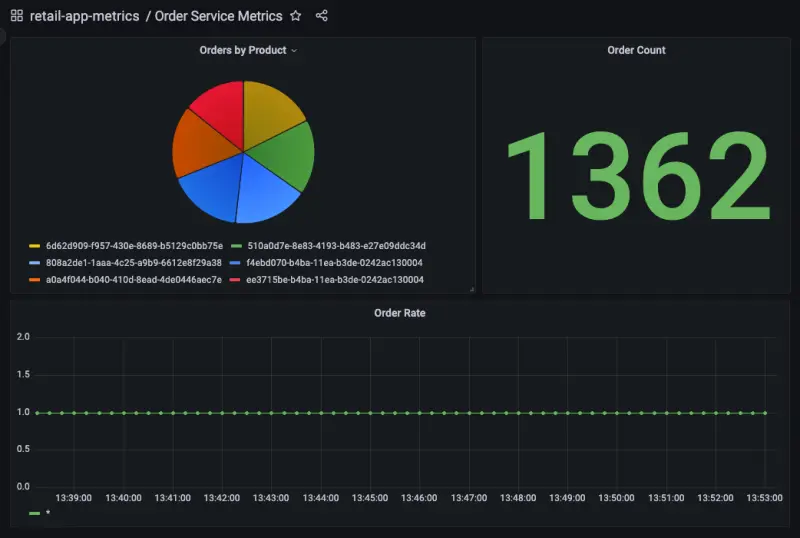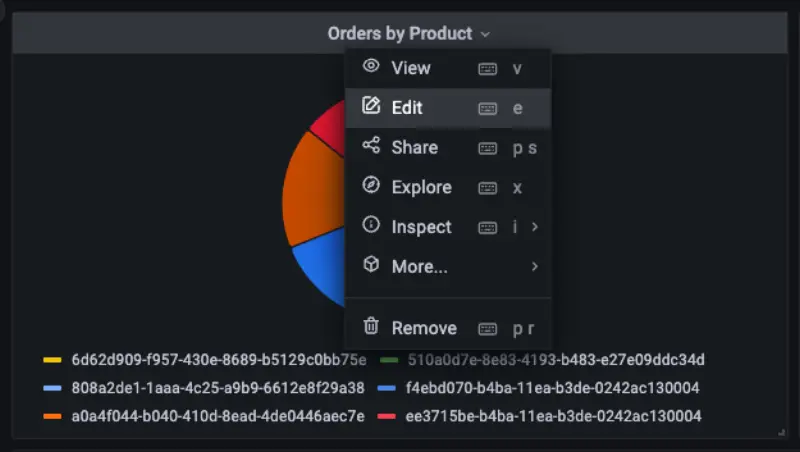アプリケーションメトリクス
この章では、ワークロードによって公開されるメトリクスの洞察を得る方法を検討します。例としては以下のようなものがあります:
- Javaヒープメトリクスやデータベース接続プールのステータスなどのシステムメトリクス
- ビジネスKPIに関連するアプリケーションメトリクス
AWS Distro for OpenTelemetryを使用してアプリケーションメトリクスを取り込み、Grafanaを使用してメトリクスを可視化する方法を見てみましょう。
このワークショップの各コンポーネントは、特定のプログラミング言語やフレームワークに関連するライブラリを使用してPrometheusメトリクスを提供するように計装されています。以下のように注文サービスからのメトリクスの例を見ることができます:
[...]
# HELP jdbc_connections_idle Number of established but idle connections.
# TYPE jdbc_connections_idle gauge
jdbc_connections_idle{name="reader",} 10.0jdbc_connections_idle{name="writer",} 10.0[...]
# HELP watch_orders_total The number of orders placed
# TYPE watch_orders_total counter
watch_orders_total{productId="510a0d7e-8e83-4193-b483-e27e09ddc34d",} 2.0watch_orders_total{productId="808a2de1-1aaa-4c25-a9b9-6612e8f29a38",} 1.0watch_orders_total{productId="*",} 3.0watch_orders_total{productId="6d62d909-f957-430e-8689-b5129c0bb75e",} 1.0このコマンドの出力は冗長なので、上記の例では以下を示すために整理されています:
- システムメトリクス - アイドル状態のJDBC接続の数
- アプリケーションメトリクス - 小売店を通じて注文された数
チェックアウトサービス��など、他のコンポーネントに対して同様のリクエストを実行できます:
[...]
# HELP nodejs_heap_size_total_bytes Process heap size from Node.js in bytes.
# TYPE nodejs_heap_size_total_bytes gauge
nodejs_heap_size_total_bytes 48668672
[...]
このラボでは、ADOTを活用してすべてのコンポーネントのメトリクスを取り込み、注文された数を表示するダッシュボードを探索します。アプリケーションポッドからメトリクスをスクレイピングするために使用されるOpenTelemetry設定、特にこのセクションを見てみましょう:
job_name: 'kubernetes-pods'
honor_labels: true
kubernetes_sd_configs:
- role: pod
relabel_configs:
- source_labels: [__meta_kubernetes_pod_annotation_prometheus_io_scrape]
action: keep
regex: true
- source_labels: [__meta_kubernetes_pod_annotation_prometheus_io_scrape_slow]
action: drop
regex: true
- source_labels: [__meta_kubernetes_pod_annotation_prometheus_io_scheme]
action: replace
regex: (https?)
target_label: __scheme__
- source_labels: [__meta_kubernetes_pod_annotation_prometheus_io_path]
action: replace
target_label: __metrics_path__
regex: (.+)
- action: labelmap
regex: __meta_kubernetes_pod_annotation_prometheus_io_param_(.+)
replacement: __param_$1
- action: labelmap
regex: __meta_kubernetes_pod_label_(.+)
- source_labels: [__meta_kubernetes_namespace]
action: replace
target_label: namespace
- source_labels: [__meta_kubernetes_pod_name]
action: replace
target_label: pod
- source_labels: [__meta_kubernetes_pod_phase]
regex: Pending|Succeeded|Failed|Completed
action: drop
この設定は、PrometheusのKubernetes サービスディスカバリメカニズムを活用して、特定のアノテーションを持つすべてのポッドを自動的に検出します。この特定の設定は、アノテーションprometheus.io/scrapeを持つすべてのポッドを検出し、スクレイピングするメトリクスに名前空間やポッド名などのKubernetesメタデータを追加します。
orders コンポーネントのポッドのアノテーションを確認できます:
prometheus.io/path: /actuator/prometheus
prometheus.io/port: "8080"
prometheus.io/scrape: "true"
クラスターメトリクスのセクションで見たように、これらのポッドメトリクスも同じOpenTelemetryエクスポーターを使用してAMPに送信されます。
次に、以下のスクリプトを使用してロードジェネレーターを実行し、ストアを通じて注文を行い、アプリケーションメトリクスを生成します:
前のセクションで行ったようにGrafanaを開きます:
ダッシュボードページに移動し、Order Service Metricsダッシュボードをクリックして、ダッシュボード内のパネルを確認します:

「Orders by Product」パネルのタイトルにカーソルを合わせ、「Edit」ボタンをクリックすることで、ダッシュボードがAMPをクエリするように設定されている方法を確認できます:

このパネルの作成に使用されたPromQLクエリはページの下部に表示されます:
この場合、次のクエリを使用しています:
sum by(productId) (watch_orders_total{productId!="*"})
これは以下のことを行っています:
watch_orders_totalメトリクスをクエリするproductIdの値が*のメトリクスを無視する- これらのメトリクスを合計し、
productIdでグループ化する
同様に他のパネルを探索して、それらがどのように作成されたかを理解できます。
メトリクスの観察に満足したら、以下のコマンドを使用してロードジェネレーターを停止できます。